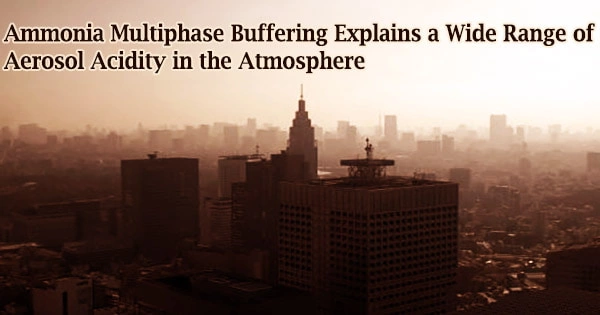Aerosols are airborne particles that are either solid or liquid. They have an impact on the climate because they absorb or scatter sunlight and act as cloud condensation nuclei. Furthermore, the negative health impacts of fine particulate matter might have an influence on human well-being.
Nitrate, sulfate, and ammonium ions make up a significant portion of particulate matter. Aerosol acidity, which varies greatly between places with pH values ranging from 1 to 6, has a significant impact on the development of these key aerosol components. The causes of these huge variances, on the other hand, are unknown.
The importance of the water content and overall mass concentration of aerosol particles for their acidity has now been discovered by researchers. These characteristics may be even more essential than the dry particle composition, according to a team led by Yafang Cheng and Hang Su from the Max Planck Institute for Chemistry.
They discovered that the conjugate acid-base pair of ammonium ions and ammonia (NH4+/NH3) may efficiently buffer and regulate aerosol pH at varying levels in inhabited continental areas with substantial anthropogenic ammonia emissions from agriculture, traffic, and industry.
The research, which was just published in the interdisciplinary magazine ‘Science,’ began with the topic of whether and how the pH of aerosols is buffered in various continental regions.
Globally, ~70% of urban areas are in the ammonia-buffered regime. Thus, the newly discovered multiphase buffer mechanism is important to understand haze formation and aerosol effects on human health and climate in the Anthropocene.
Hang Su
Mainz scientists created a new theory of multiphase buffering in aerosols, evaluated atmospheric measurement data, and ran global model simulations of aerosol composition and acidity to solve this issue.
“It turned out that the acid-base pair NH4+/NH3 is buffering the aerosol pH over most populated continental areas, even though the acidity may vary by multiple pH units,” says Yafang Cheng, Minerva Research Group leader at the Max Planck Institute for Chemistry.
“Variations in water content are responsible for 70-80 percent of global variability in aerosol pH in ammonia-buffered regions, which was not previously known and can be explained by our new multiphase buffer theory,” she adds.
The Max Planck researchers used their model to compare aerosol composition and acidity for two geographical regions and conditions that were significantly different. During the summer in the southeastern United States, the air is clean, and the few atmospheric aerosol particles contain little water at pH values around ~1, whereas in the winter over the North China Plain, there are typically high aerosol concentrations with high water content at pH values around ~5.
“We find that these large differences in aerosol pH are primarily due to differences in aerosol loading and water content rather than differences in the nitrate content as assumed in earlier studies,” explains Guangjie Zheng, a postdoc in Yafang Cheng’s group.
“Globally, ~70% of urban areas are in the ammonia-buffered regime,” summarizes Hang Su, scientific group leader in the Multiphase Chemistry Department of the institute.
“Thus, the newly discovered multiphase buffer mechanism is important to understand haze formation and aerosol effects on human health and climate in the Anthropocene.”
The findings of Cheng and Su’s group not only show that human influence on ammonia emissions and the nitrogen cycle in the Anthropocene has a significant impact on aerosol pH and atmospheric multiphase chemistry. They also contribute to a better knowledge of how air pollution develops, paving the way for potential control strategies.





